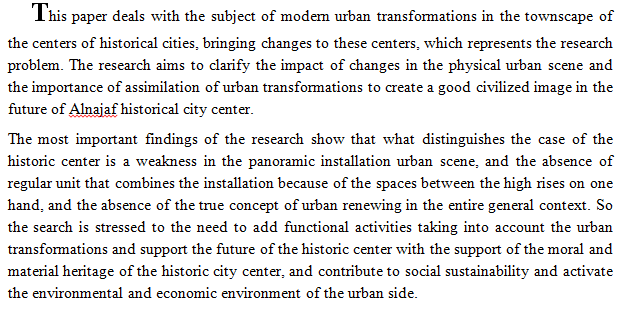
4-aminobenzenesulfonamide conjugates of ibuprofen (compound 10) and indomethacin (compound 11) have been designed and synthesized by the reaction of sulfanilamide (compound 7) with 2-(4-isobutylphenyl) propanoic acid (ibuprofen) and 2-(1-(4-chlorobenzoyl)-5-methoxy-2-methyl-1H-indol-3-yl)acetic acid (indomethacin) for the evaluation as potential anti-inflammatory agents with expected selectivity against COX-2 enzyme. In vivo acute anti-inflammatory activity of the synthesized final compounds (10 and 11) was evaluated in rats using egg-white induced edema model of inflammation in a dose equivalent to (10mg/Kg) of ibuprofen and (2mg/kg) of indomethacin. The tested compounds pr
... Show More (1)
(1)
A new 4-thiazolidinone, substitutedbenzylidene-thiazolidinone and tetrazole were synthesized from thiosemicarbazone and hydrazone. The thiosemicarbazone was prepared by the reaction of thiosemicarbazide with aldehyde derivative from L-ascorbic acid in absolute ethanol using glacial acetic acid as a catalyst. 1, 3-thiazolidin-4-ones were synthesized from the condensation of thiosemicarbazones with chloroacetic acid in presence of anhydrous sodium acetate. A 1, 3- thiazolidine-4-one was reaction with several 4-substitutedaldehydes to produce new derivatives with a double bond at the position-5 of the 4-thiazolidinone ring. While the tetrazole compounds were synthesized by 1, 3-cycloaddition reaction of sodium azide and hydrazone compounds in
... Show More2-amino-4-(4-chloro phenyl)-1,3-thiazole (1) was synthesized by refluxing thiourea with para-chloro phenacyl bromide in absolute methanol. The condensation of amine compound (1) with phenylisothiocyanate in the presence of pyridine will produce 1-(4-(4-chlorophenyl)thiazol-2-yl)-3-phenylthiourea(2), which is upon treatment with 2,4 dinitrophenyl hydrazine by conventional method, afforded 1- ( 4 - ( 4 – chlorophenyl ) thiazol – 2 – yl ) – 3 - phenylhydrazonamide,N' - ( 2 , 4 -dinitrophenyl) ,(3).The characterization of the titled compounds were performed utilizing FTIR spectroscopy, 1HNMR and CHNS elemental analysis, and by me
... Show More (7)
(7)
 (2)
(2)
In this research we prepared shiff bases unilateral claw( benzyl imine aniline ) and Bilateral claw ( benzayal-2-imine phenol ) in high purity reach to 98% , which it's prepared from aromatic amine with aldehydes, it's solid,thermosetting, not dissolved in water in general. Diagnosed prepared article by using infra red spectroscopy (IR) which shows azomethen grop at 1640cm-1 At this diagnosis we suggest tetra headral mechanism in this Circumstances For a reaction.
The first molecular research on Iraqi centipede fauna is presented in this article. Between October 2022 and May 2023, during various climatic circumstances, centipedes were collected from several locations in four provinces of Iraq. Three families, represented by four genera, underwent molecular identification, and five species were found. From the order Scolopendromorpha family Scolopendridae, two species were recorded, Scolopendra morsitans Linnaeus, 1758, and S. cingulata Latreille, 1829, Cormocephalus sp.; while from the order Lithobiomorpha, family Lithobiidae, one species was recorded for first time in Iraq; Lithobius crassipes L. Koch, 1862 from the order Geophilomorpha family Himantariidae, one species Bothriogaster Signata
... Show MoreA theoretical study has been proposed to investigate the effects of different laser radiations (Nd - glass, DF and C02) as a heating source on different glass samples (Optical glass, Bk - 7 and Soda - lime glass) and different waves lengths (10.6, 3.8, 1.6) ???. The heat changes as which are resulted due irradiation with laser sources have been determined by using the one dimension mathematical relation as a function of time (t) and depth (z). The results of the study show ed that the irradiation with C02 laser had a greater effect than DF laser, while the effects of Nd - glass laser were minimal with a power density of (1.8*10?? w/m2) within atime(l^sec).(Forboth Kinds) The change in the temperatures were not exceeded than (70"K) in all sa
... Show MoreChitosan (CH) / Poly (1-vinylpyrrolidone-co-vinyl acetate) (PVP-co-VAc) blend (1:1) and nanocomposites reinforced with CaCO3 nanoparticles were prepared by solution casting method. FTIR analysis, tensile strength, Elongation, Young modulus, Thermal conductivity, water absorption and Antibacterial properties were studied for blend and nanocomposites. The tensile results show that the tensile strength and Young’s modulus of the nanocomposites were enhanced compared with polymer blend [CH/(PVP-co-VAc)] film. The mechanical properties of the polymer blend were improved by the addition of CaCO3 with significant increases in Young’s modulus (from 1787 MPa to ~7238 MPa) and tensile strength (from 47.87 MPa to 79.75 MPa). Strong interfacial
... Show More (2)
(2)
 (3)
(3)
 (2)
(2)
